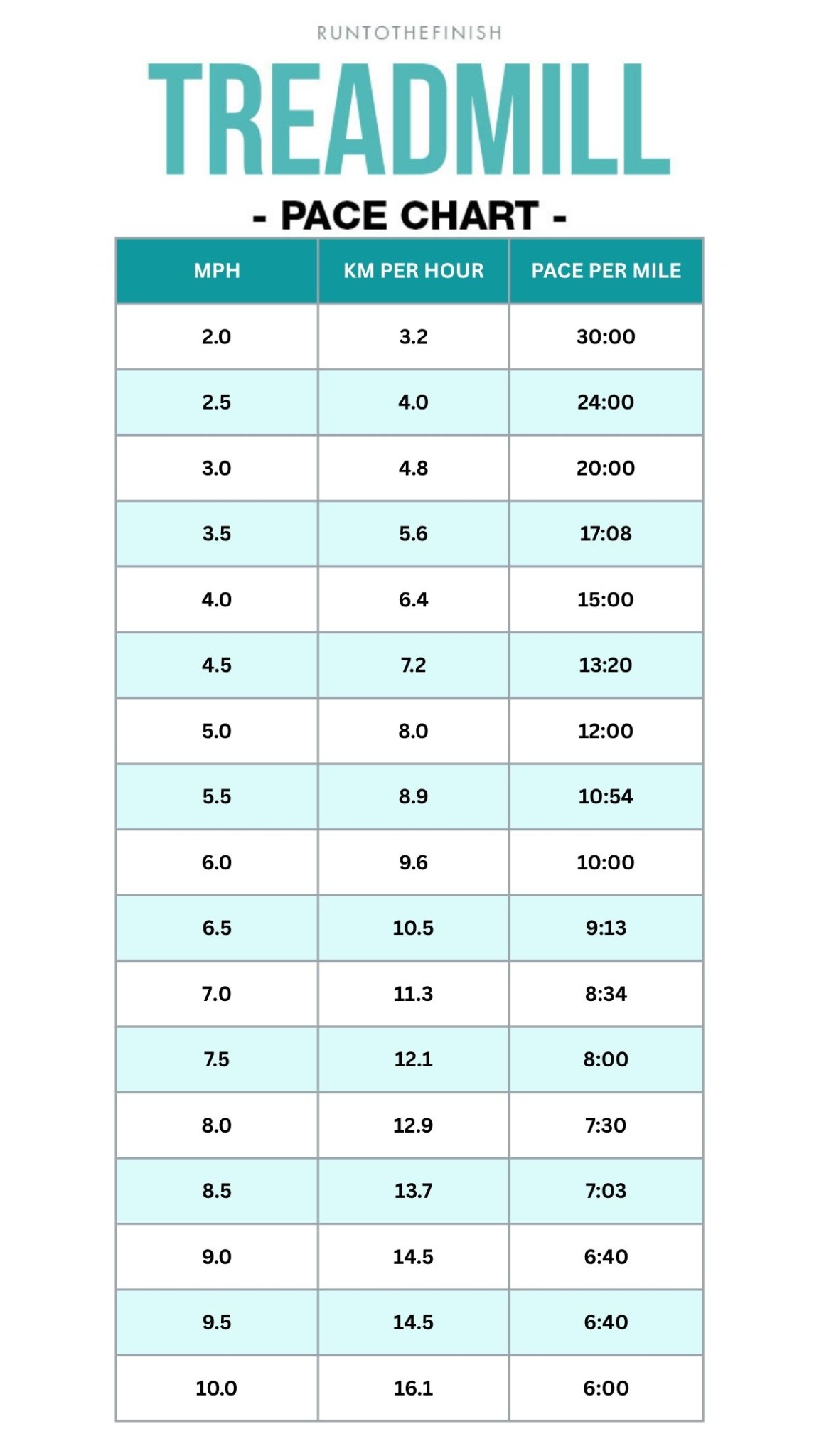Ever hop on the treadmill, set a speed, and immediately wonder what that actually means for your pace outside? That’s why we pulled together a treadmill pace conversion chart you can save, screenshot, and finally stop guessing.

Below you will find a chart with conversions from MPH or km/h to pace per mile or kilometer. And because we know things like incline can totally change how a run feels, we’ve added a few tips about that too.
A treadmill is a helpful tool, and even more so if you understand treadmill paces and how they work. By the end, you’ll feel more confident using the treadmill for everything from easy miles to speed workouts… no math required.
Remember to review the treadmill training guide for more tips around how to utilize incline, treadmill workouts and more. As a quick reminder, NO you don’t need to do all your mileage at 1% to mimic running outside.
Why Use a Treadmill Pace Chart?
It’s a widely used tool for converting treadmill speeds in miles per hour (MPH) to running paces (in minutes per mile), as well as converting those paces at different inclines.
A treadmill pace chart can help you figure out outdoor and indoor running paces.
As discussed in treadmill vs outside running, both are equally effective methods of training. But some of you want to get a better feel for how your paces compare from one to the other.
In other words, if you generally run outside, the treadmill pace chart will assist you in determining your ideal pace on days when you need to log miles inside. What’s key is to remember that just because you run one pace outside doesn’t mean it will be the same inside. Perhaps the treadmill feels harder for you or it’s hotter or you’re just tired!
It can also help you find your best speed for a hill workout, or even just to make sure you’re running at the right minute-per-mile pace for a speed workout.
Based on studies these are equivalent pace when running on a flat road, up until about 7 min and faster. Then you need to add incline to keep it the same.
Treadmill Pace Chart: Speed Conversions from MPH and KM/H to Pace
While the average treadmill goes from 1 to 12MPH, this chart is not quite that robust. Instead, let’s look at some of the basic numbers to give you an idea of how fast you are walking or running on the treadmill.
Table one is going to provide your miles per hour to minutes per mile conversion. Remember that 4.0MPH is the power walking pace I encourage people to work towards.

What Pace Should You Run on The Treadmill?
There is no such thing as a good treadmill pace. Which means that the pace you’ll be using is going to vary by the goal of your run, current fitness and honestly the treadmill!
That’s right, some treadmills are downright harder. They haven’t been calibrated in awhile and may be at an incline, not rotating precisely or in a super hot room.
Every run should start with pre-run stretches, followed by some easy walking and then even a light jog in to your run.
Instead of worrying about the exact pace you should run, focus on the effort of your workout. By keeping easy days easy and going hard enough on your speed workouts, you will absolutely make progress. Which is the goal, not hitting a certain pace on your easy days.
That being said, only those doing sprints or those that are elite runners will be using the 12.0 MPH setting! Most folks should start with a 3.0 to 4.0 for walking and then graduate to 5.0-7.0 for most easy runs.
Where you fall in that range is going to vary even from day to day!
And make sure to warm up on the treadmill at a speed that’s a little lower than your easy running pace. This is because you’ll also find that running on a treadmill feels different in your legs due to the difference in terrain.
Regardless, pay attention to the effort levels and try it to match your regular workouts as much as possible.
How Does Your Treadmill Affect Pacing?
Not all treadmills are the same. Apart from calibration issues, the quality of the deck and the stability of the machine itself can also affect how efforts feel at different paces.
For example, heavier machines that are more stable will often make you feel less load on your body when running at higher output and with higher forces.
This is often why slower paces feel more comfortable for outdoor running than indoors on a treadmill. Similarly, many runners will find that at faster paces, running on a treadmill generally feels more sustainable.
Part of this has to do with the running surface in general, and the environment you have, thanks to factors like lack of wind resistance.
But again, that still depends on the type of treadmill you’re running on. If you’ve read my guide of curved treadmills, you’ll know how those are a lot different than traditional ones as well.
There’s also the Wahoo KICKR Treadmill that can mimic the side-to-side tilt that you would experience running outside, which will also change your pace and effort.
In general, use this chart while getting a feel for your RPE to fully understand what paces are the right ones for YOU.
What If I Want to Find My Pace Without a Treadmill Pace Chart?
You can use a few other things to figure out your speed if you don’t know your mile pace. This is useful if you’re going for an easy run or want to do an interval workout on a treadmill.
If you’re not sure what speed to run at, I recommend focusing on your rate of perceived exertion (RPE) or the level of effort at which you’re running.
On a treadmill, for example, you can begin by running at a conversational effort, which is roughly 4 to 6 RPE on a scale of 1 to 10.
A decent guideline for converting that effort into treadmill speeds for a conversational effort is between 3.5 and 6.0 mph.
But like I said, it is only a guideline – you may be faster or slower depending on your level of fitness and how you feel.
Once you have a good idea of your conversational pace, you can move on to other paces, such as your marathon or half marathon efforts.
Treadmill Pace Chart with Incline
What you’ll notice here is that 0% on the treadmill is considered slightly slower than running on flat ground. What we know from a 2019 study is that the actual oxygen consumption of the body remains the same, BUT the effort does appear to be easier as noted by things like a lower heart rate.
This is because you aren’t dealing with wind, weather, cars, sidewalks — all the things we need to remain alert for the entire time we’re moving. The easy applies to those times you’re running below a 9 minute mile.
Meanwhile running sprints or other speed work on the treadmill, actually increases the heart rate more than running outside. Thus making it feel harder.

Treadmill Incline Impact on Pace
As noted you don’t need to spend all your time on the treadmill at 1%, this could actually overwork the hip flexors.
But it is valuable to change up your incline throughout the workout. These numbers help to compare the effort level of running on flat ground to running at an incline.
This gives you an idea of the increased intensity AND should show you the benefit of adding more hills to your workouts! It’s going to make you stronger and it’s like doing speed work with less chance of injury.
✅If you’ve got a specific race goal in mind, then check out the running training paces calculator to dial in your training paces!
Looking for some additional treadmill tips?
- Best Treadmill Running Shoes
- Why do I feel slower on the treadmill?
- Is my watch or my treadmill right?
Other ways to connect with Coach Amanda
Instagram Daily Fun: RunToTheFinish
Facebook Community Chatter: RunToTheFinish
Sign Up to Receive a Weekly Newsletter with Top Running Tips and Laughs
The post Treadmill Pace Conversion Chart and Tips appeared first on RunToTheFinish.
from RunToTheFinish https://ift.tt/BSeOLZ3

Post a Comment
Post a Comment